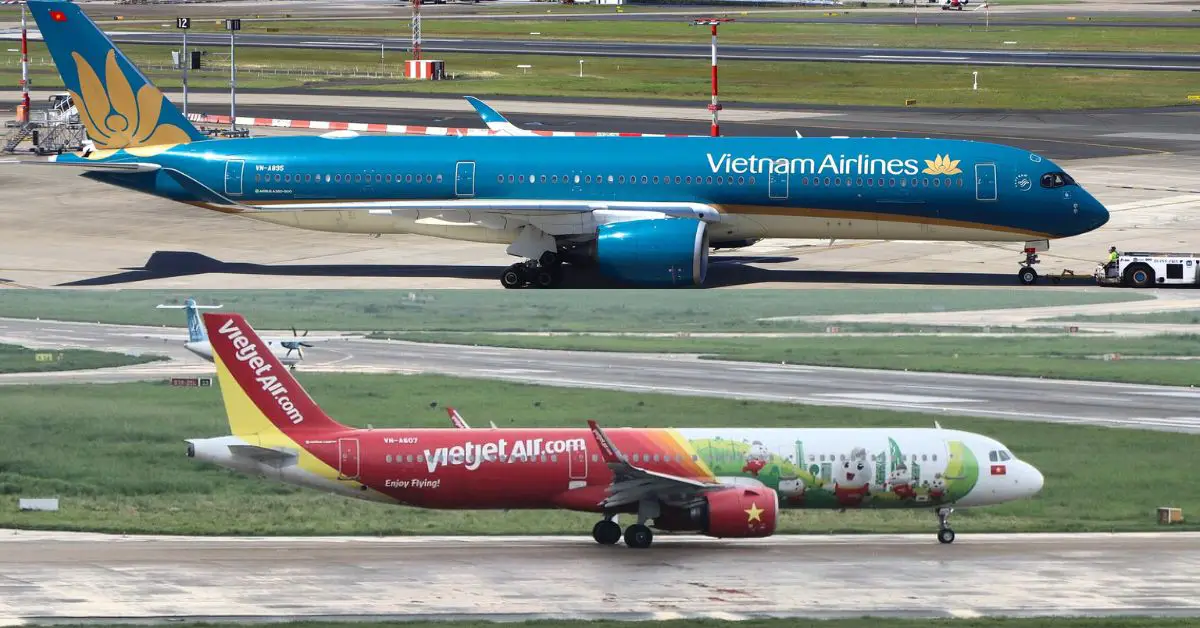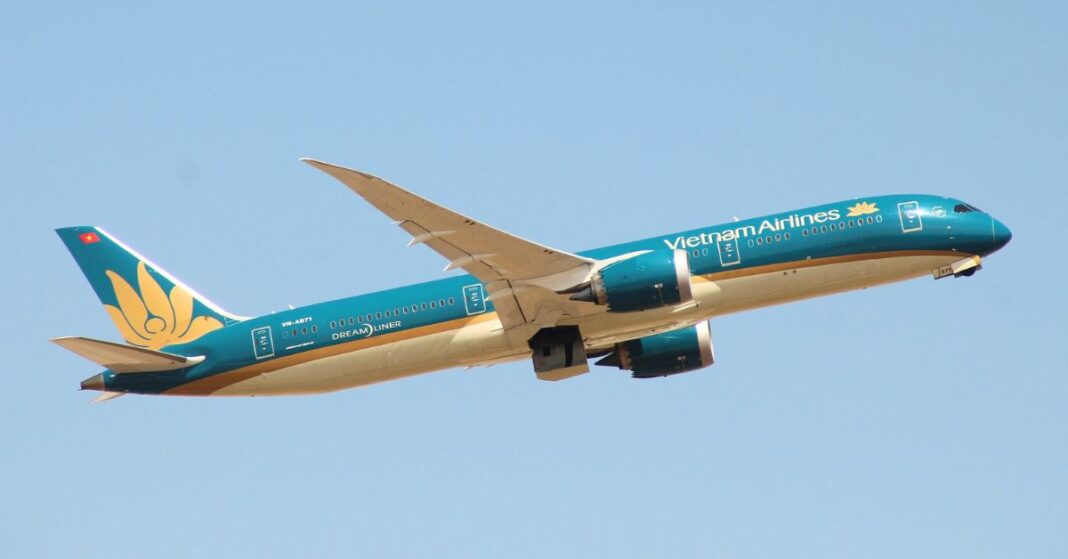In the rapidly evolving world of aviation, Vietnam stands out as an intriguing case study. The country’s airline industry is characterized by substantial growth and intense rivalry, in a landscape populated by both established carriers and ambitious newcomers.
This blog provides an in-depth look into the dynamics of Vietnam’s airline sector, probing the strategies and innovations that lead to industry leadership, and the growth prospects and potential pitfalls that pave the road ahead.
Table of Contents
What is the main airline in Vietnam?
Vietnam’s primary airline is Vietnam Airlines, serving as the national flag carrier. Established in 1956, this state-owned enterprise is headquartered in Hanoi, with key operational hubs at Noi Bai International Airport and Tan Son Nhat International Airport. Vietnam Airlines boasts a comprehensive network encompassing both domestic and international flights, covering 117 routes across 19 countries (excluding codeshare services).
Which airline of Vietnam is best?
Although Vietnam Airlines stands out as the premier national carrier with the most extensive network and a solid reputation, selecting the “optimal” airline depends on your specific preferences.
If you prioritize diverse options, smooth connections, and comfort, Vietnam Airlines sets the standard. However, for budget-conscious travelers, VietJet Air and Pacific Airlines provide no-frills deals, while Bamboo Airways entices with competitive fares and distinctive destinations. Ultimately, factor in considerations such as route choices, travel class requirements, baggage allowances, and personal preferences to navigate Vietnam’s skies and discover the ideal flight for your adventure.
Which is the national airline of Vietnam?
Vietnam’s national airline is Vietnam Airlines, proudly representing the country’s flag in the skies. Established in 1956, it holds the distinction of being not only the oldest but also the largest airline in Vietnam, with an expansive network and a robust reputation for safety and service.
Which is better VietJet or Vietnam Airlines?

When deciding between VietJet and Vietnam Airlines, your choice hinges on your preferences:
VietJet:
Pros:
- Price: Offers significantly cheaper fares, especially for basic options.
- Frequency: Often provides more flight choices, particularly on well-traveled routes.
- Modern Fleet: Operates newer aircraft with comfortable seating.
Cons:
- Amenities: Limited service, no complimentary meals or entertainment.
- Fees: Accumulates baggage fees, and extras like seat selection come with additional costs.
- Reliability: Slightly higher risk of delays compared to Vietnam Airlines.
Vietnam Airlines:
Pros:
- Service: Known for excellent customer service, offering complimentary meals and entertainment in most classes.
- Reliability: Maintains a strong track record for on-time performance and safety.
- Network: Boasts an extensive network covering more destinations, both domestically and internationally.
- SkyTeam Membership: Provides access to lounges and baggage transfer with partner airlines.
Cons:
- Price: Significantly more expensive than VietJet, especially for basic fares.
- Frequency: Offers fewer flight options on some routes, especially budget choices.
- Fleet: Includes some older aircraft, although they are still safe and comfortable.
Ultimately, the better choice depends on:
- Budget: VietJet is the clear winner if price is your top priority.
- Travel Needs: Vietnam Airlines is preferable if you require specific amenities like meals or entertainment.
- Reliability: If punctuality is crucial, Vietnam Airlines has a better track record.
- Route: Check availability and compare prices for your specific journey.
Quick Summary:
- Choose VietJet for: Budget travel, popular routes, modern aircraft.
- Choose Vietnam Airlines for: Full-service experience, reliability, wider network, SkyTeam benefits.
Which is the safest airline in Vietnam?
Both Vietnam Airlines and VietJet Air boast excellent safety records in Vietnam, making it challenging to unequivocally declare one as inherently “safer” than the other.
Overview of Vietnam’s Airline Industry
An opportunist gaze at the airline industry in Vietnam reveals a fascinating environment fueled by heady expansion, innovation, and changing trends. This Southeast Asian country, known for its profound spirit of endurance and adaptability, stands as a shining example within the aviation industry. The burgeoning sector paints a promising picture filled with compelling dynamics, thrilling possibilities, and noteworthy characteristics.
Unprecedented Development Pace
One defining feature of the Vietnamese airline industry is its remarkable pace of growth. Over the last decade, the industry has flourished like few other Asian markets. According to the International Air Transport Association (IATA), Vietnam is expected to become the world’s third fastest-growing market for international passengers and freight. Air travel within Vietnam has seen exponential growth, second to none globally, thanks to a rapidly growing middle class with increasing disposable income, urbanization, and steady economic growth.
Emergence Of Low-Cost Carriers
A striking characteristic defining the landscape of the airline industry in Vietnam is the meteoric rise in popularity of low-cost carriers. Over recent years, conventional full-service airlines have seen fierce competition from budget-friendly carriers such as VietJet Air, Bamboo Airways, and Pacific Airlines. Their ability to marry affordability with quality service has propelled their civic popularity, catalyzing a paradigm shift in the industry that favors consumer-centric pricing models and inventive services.
Technological Integration And Innovation
The Vietnamese airlines are not just navigating the tumultuous skies of competition but also fueling their journey with cutting-edge technology. A shift towards digital platforms for booking and managing flights, check-in, ancillary services, and customer care is a testament to this trend. Meticulously designed mobile applications, AI chatbots, and VR-based cabin experiences demonstrate a strong commitment to leveraging technology to enhance customer experiences and streamline operations.
Regulatory Support And Infrastructure Development
Another enticing feature of Vietnam’s aviation scene is the government’s supportive regulatory framework to encourage the growth of the sector. Eye-catching infrastructure projects, including the construction of Long Thanh International Airport, earmarks that commitment. Moreover, relaxed foreign ownership laws and streamlined bureaucratic procedures have been a boon for international investors.
Competitive Landscape
It would be remiss to overlook the competitive streak that runs deep in Vietnam’s airline industry. Despite the pandemic hitting the sector hard globally, Vietnamese airlines have shown tenacity, turning adversity to their advantage. The fallout of the pandemic has also leveled the playing field, with companies turning towards innovation and strategic partnerships to enhance competitiveness and survive in the post-COVID scenario.
And this, friends and esteemed colleagues, is the exciting, challenging, and promising panorama of the airline industry in Vietnam. It’s a thrilling time for entrepreneurial adventurers and savvy investors looking to ride the thermals of this rising market.
The industry offers a wealth of opportunities for technological innovation, service revolution, and customer experience enhancement. Oblivious to the downturn caused by the pandemic, this convoluted market is shaping into a nexus of growth and innovation, ready for the savviest to reap the benefits.
Analysis of Major Players
A bravura blend of adaptability, resilience, and foresight, the airline industry in Vietnam continually seizes the opportunities afforded by the country’s rapid, unprecedented development pace. With the rise of low-cost carriers, increasing digitization, regulatory support, and infrastructure improvements, the aviation landscape is diversifying and becoming intense. This article delves into Vietnam’s top airlines and the competitive strategies that set them apart.
A mature player in this arena, Vietnam Airlines is the country’s national flag carrier and has demonstrated remarkable flexibility and sagacity. As a Skytrax 4-star airline, it set itself apart through service excellence and safety standards. Not resting on its laurels, the airline has honed its pursuit of competitive advantage, investing heavily in fleet modernization.
It grasped the long-range, efficient features of the Airbus A350 and Boeing 787 Dreamliner, making it the first Asian airline to platform both. But the real clincher lies in its brand localization strategy; by leveraging the rich cultural heritage and hospitality of Vietnam, it has curated an authentic, differentiated in-flight experience.
No stranger to innovation, VietJet Air, Vietnam’s leading private airline, has redefined the low-cost carrier concept. Spearheading a resonant ‘cost we care’ philosophy, it prioritizes affordability while maintaining a robust service palette through ancillary revenue streams.
This all-women-flight-crew airline has also won public affinity through its branding strategy, emulating a modern, vibrant, and bold Vietnam. Additionally, it aims to kill two birds with one stone with its route expansion strategy, by meeting passenger demand and promoting Vietnamese tourism simultaneously.
Jetstar Pacific – a strategic collaboration between Vietnam Airlines and Qantas Airways – embodies its tagline “all day, every day, low fares”. It has leveraged economies of scale, operational synergies, and dual brand strategy to provide superior value offers. An agile adoption of digital sales channels and harnessing data intelligence for improved service customization also bolsters its competitiveness.
Bamboo Airways, a hybrid between traditional and budget airlines, brings a fresh perspective to the Vietnam skies. Their business strategy focuses on punctuality, friendly services, and safety. Crucially, they are adept in identifying untapped routes, and servicing less touristy but scenic destinations – a real game-changer for the experiential traveler.
Vietnam’s airline industry today vibrates with activity, movement, and, more critically, promise. The market players, through their distinct business strategies, have pivoted from just surviving to thriving in the sector. Their cumulative efforts are pushing individual boundaries and raising the bar for Vietnam’s airline industry as a whole.
Market Innovations and Customer Experience
Vietnamese airlines are going beyond the industry norms by adopting innovative practices and focusing on customer-centric solutions. In the quest to provide an exceptional passenger journey and remain at the forefront of the aviation industry, they are leveraging cutting-edge technology, smart partnerships, and creative business strategies.
One of the captivating advancements is the use of Artificial Intelligence (AI) to personalize the travel experience, making it more engaging and enjoyable. Airlines like Bamboo Airways and Vietnam Airlines employ data-driven AI techniques to provide personalized offerings such as meal preferences, baggage handling, and check-in assistance to their consumers based on their past preferences and behavior.
Taking customization a notch higher, Vietnamese airlines are utilizing Virtual Reality (VR) and Augmented Reality (AR) technology to enhance in-flight services and experiences. Imagine trying on your holiday outfits and ordering them for home delivery or exploring your destination landmarks – all while at 35,000 feet!
In tandem with this, they are rapidly integrating mobile and digital solutions to streamline operations, resulting in increased turn-around times and enhanced customer satisfaction.
For instance, mobile apps with features such as advanced seat selection, online flight check-in, and luggage tracking are widely used. Digital wallets and e-payment systems, like the one employed by VietJet Air, have not only made transactions seamless but also provided better transparency.
Vietnamese airlines are sizeably investing in sustainability initiatives, signifying their commitment to social responsibility and the environment. Bamboo Airways, for instance, has pledged to become the first carbon-neutral airline in Vietnam by 2023.
Strategic partnerships are another effective formula for boosting competitive positioning. By engaging in alliances and officiating interline agreements, Vietnamese airlines are simplifying traveling for passengers by offering them a wider flight network under one booking, as demonstrated by the collaboration between Jetstar Pacific, Vietnam Airlines, and Qantas Airways.
While delivering great service is important, safeguarding customer satisfaction through top-notch safety measures cannot be overlooked. By adopting the IATA’s Operational Safety Audit (IOSA), Vietnamese airlines have not only refreshed safety standards but are also reinventing trust with their passengers.
In the end, to stay ahead in the aviation business, Vietnamese airlines are relentlessly pursuing out-of-the-box strategies from technology to alliances, environmental initiatives to customer focus, and much more. All in due course to craft a better, brighter flight experience for every passenger. Vietnam’s aviation industry, thus, establishes itself as a global contestation, built on robust innovation and distinct customer-centric strategies—an excellent symbol of Vietnamese dynamism and resilience utilized for fostering an invincible future in air travel.
Future Prospects in Vietnam’s Airline Industry
Influencing Market Forces And Demographic Factors
While the growth trajectory of Vietnam’s aviation industry has thus far been shaped by numerous factors, one predictor of future trends could be the shifting demographics and the liberalizing market forces. As the Vietnamese middle class expands, their increased spending capacity would likely reflect a surge in air travel demand. International tourist arrivals, another significant contributor to the airline industry’s passenger booklets, are also projected to grow, subject to COVID-19 developments and recovery.
Vietnam’s location as a strategic hub between the Asia-Pacific and the Middle East I believe will play a vital role in shaping its aviation future. Since these markets are home to a majority of the world’s population and boast fast-growing economies, the potential for increased air travel demand from and to these economies is immense.
Innovation Through Partnerships
Partnerships, collaborations, and alliances are already shaping the future of the aviation industry at a global level. Airlines are increasingly recognizing the viability of these strategies to overcome the complex business environment and to leverage each other’s strengths for mutual benefits. For instance, key partnerships with global industry players can help Vietnamese airlines enhance their international reach and increase the allure for international travelers.
With a global shift towards a more environmentally aware society, sustainability partnerships offer a great opportunity for airlines to collaborate with aviation technology firms or biofuel companies. Such strategic alliances can significantly reduce the carbon footprint of airlines, earning them the critical credibility of being responsible corporate citizens.
Increased Focus on Customer Experience
With an understanding of the evolving customer preferences, Vietnamese airlines are likely to continue placing a strong emphasis on enhancing the customer experience. This could include personalized experiences via AI, increased use of VR and AR in-flight, and even biometric technology for smoother airport processes. Airlines are expected to continually fine-tune their service offerings to resonate with their target customer segments.
Risk Management and Planning
Future aviation industry leaders will be those who effectively manage risks and anticipate changes. Foresight planning – adjusting strategies according to different potential future scenarios – will become more critical than ever for Vietnamese airlines.
Conclusion
Considering the discussed points, it appears clear that the future holds intriguing prospects for airlines in Vietnam. Decision-makers should stay alert to global industry trends, and emerging market demands, and innovatively position their respective airlines to maximize the opportunities that arise. While uncertainty remains a defining feature of the industry, with the right strategies and adaptability, the future of aviation in Vietnam could soar to even greater heights.
Emerging trends, potential regulatory changes, and market forecasts, all play a vital role in shaping the future of Vietnam’s airline industry. Recognizing the interplay of these factors is crucial in understanding the trajectory of this burgeoning sector.
The analysis presented in this paper showcases the inherent dynamism of the Vietnamese market, drawing attention to both the impressive resilience of top industry players and the relentless drive for innovation seen across the board. These elements, alongside the key growth opportunities and challenges identified, paint a vivid picture of a vibrant industry and its journey into the uncharted skies of the future.





